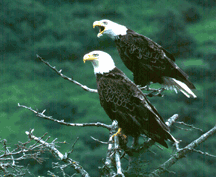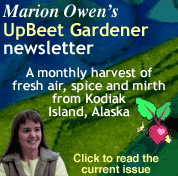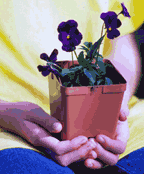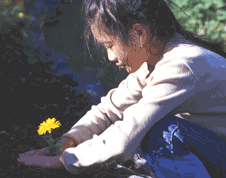
How to transplant seedlings
And what bald eagles can teach us
By Marion Owen,
Fearless Weeder for PlanTea, Inc. and
Co-author of Chicken Soup for the Gardener's Soul
FEATURE ARTICLE:

Tom Hanks' "Power of Four" solution
More good stuff:
Who is Marion Owen?
FAQs about PlanTea
Search Marion's articles, tips and recipes
Why grow organic?
News and press releases
Read love letters
How to link to this site
Need a speaker?
How to contact Marion
Visiting Alaska?
Come to Kodiak Island!
Go to home page

Marion's UpBeet Gardener
Newsletter has been
replaced by Marion's blog
which you can find at:
www.marionowen.wordpress.com
The young bald eagle inched closer to the edge of the nest and looked out over the treetops, valleys and rivers. "The world is my oyster!" he squawked. After many weeks of shedding downy feathers and eating regurgitated food, was time to learn how to fly.

A pair of bald eagles
on Kodiak Island try to
encourage the young eagles to fly.
Photo by Marion Owen
Just hopping out of the nest would mean instant death. Some preparation was needed. By flapping his wings, day after day, he became accustomed to the feel of air moving through his giant flight feathers. When graduation day arrived, the young eagle was ready to take the big leap.
Preparing youngsters for the demands of an adult life is a universal theme of survival that applies to humans, bears, slugs (OK, maybe not slugs, but you get the idea) and plants.
 Transplanting
seedlings and bedding plants outside in the garden can be the most stressful
point in their lives. This goes for ALL bedding plants -- flowers, vegetables
and herbs -- whether you grow your own or buy them from a nursery. They
need to be "hardened off," a term that begs revamping, but it applies
to the process of preparing your seedlings by gradually acclimating them
to wind, heat, cool nights, and real rain.
Transplanting
seedlings and bedding plants outside in the garden can be the most stressful
point in their lives. This goes for ALL bedding plants -- flowers, vegetables
and herbs -- whether you grow your own or buy them from a nursery. They
need to be "hardened off," a term that begs revamping, but it applies
to the process of preparing your seedlings by gradually acclimating them
to wind, heat, cool nights, and real rain.
HELPFUL TIP: To learn more about raising seedling read my Seeding is Believing and What Seedlings Want articles. Don't know what to grow? Here are some suggestions for beginner-gardeners.
Think of the young eagle and how he prepares for the great outdoors. If you were to plop seedlings in the ground with little or no advance notice, you might as well just bury them.
This might sound drastic, but I've heard many tales of woe from gardeners who, in the excitement of a sunny spring day, have bought several flats of seedlings, buzzed home and planted them that same afternoon. Shocked with cold air, cold tap water or hot, direct sun, the poor seedlings wilt or keel over. It's just not a nice thing to do to a little plant.
"Couch potato" seedlings
Seedlings raised in a greenhouse or indoors have enjoyed a life of leisure. Free room and board with not a care in the world. Couch potato seedlings, I call them. Before throwing a coming out party, let's review how to harden off your plants, step-by-step:

- Start about a week or two before you plant out your seedlings. Set
them outdoors -- trays and all -- in a protected area, out of the direct
wind and sun. Leave them out for an hour or so (set a timer if you're
forgetful), then bring them back indoors.
- Repeat the process, increasing it to 3 hours, then a morning, then
a whole day, until they are used to a full day and a night.
- Keep them well-watered, but not swimming. It also helps to toughen
up their stems by brushing them with your hand a few times each
day.
- If the weatherman calls for frost, heavy rain or windy conditions, keep them indoors.
Why
you DON'T want nice, picnic weather
Once your plants are toughened up and ready to go in the garden, wait for a cloudy, foggy-cool or drizzly day. If no clouds are in the forecast, then aim for the coolness of the evening.
- Water plants well.
- Dig a hole slightly wider than and the same depth as the container.
For cabbage, kale, broccoli, mustard spinach, cauliflower and tomatoes,
bury their stems up to their first set of true leaves.
- If your transplants are growing in plastic pots, turn the pots upside
down and slide them out. Gently squeeze the bottom of the pot to dislodge
stubborn roots, being careful to not tear them.
About peat pots: According to peat pot manufacturers, seedlings grown in peat pots can be planted directly in the garden, pot and all. If you have cool soils though, the outer mesh doesn't break down quickly enough and the roots become all balled up. Therefore, it's a good idea to slit the sides and remove the base of the peat pot before transplanting. Tear the mesh above the soil line, too.

- Gently place the plant in the hole (which should be damp), and spread
out the roots that aren't in pots or cubes.
- Fill soil around the plant and tamp it firmly with your hands.
- Soak the base of the transplant with water or mild fertilizer.
- After planting out, pay attention to the weather. You may need to
cover individual plants with plastic milk jugs
(minus their bottoms), clear plastic, sheets, etc. to protect them from
wind, rain, frost and direct sun.
- Fertilize with compost tea or with a nutritious foliar spray made from PlanTea.
Remember, you're the gardener and therefore a cheerleader. So offer them words of encouragement like, "You can do it!"
Thanks for your interest in nurturing plants!
![]()
PS Check out the rest of my organic gardening tips.
Thanks for visiting and please stop by again. I'll put the coffee on!
Meet Marion Owen /// Learn about PlanTea /// Online Catalog /// Articles, Tips, Recipes /// Get free UpBeet Gardener newsletter /// Read current issue /// Listen to radio show /// Read news and press releases /// More resources and links /// Learn why 'grow organic?' /// View guidelines for retailers /// Read love letters /// Book Marion as a speaker /// Site map /// How to link to us /// Contact us /// Go to home page
PlanTea: The organic plant food in tea bags. http://www.plantea.com
Copyright ©1996 to present: PlanTea, Inc. All Rights Reserved. PO Box 1980, Kodiak, AK 99615-1980 USA
Questions or comments? marion@plantea.com Phone: Toll Free: 1-800-253-6331 (US and Canada); 907-486-2500